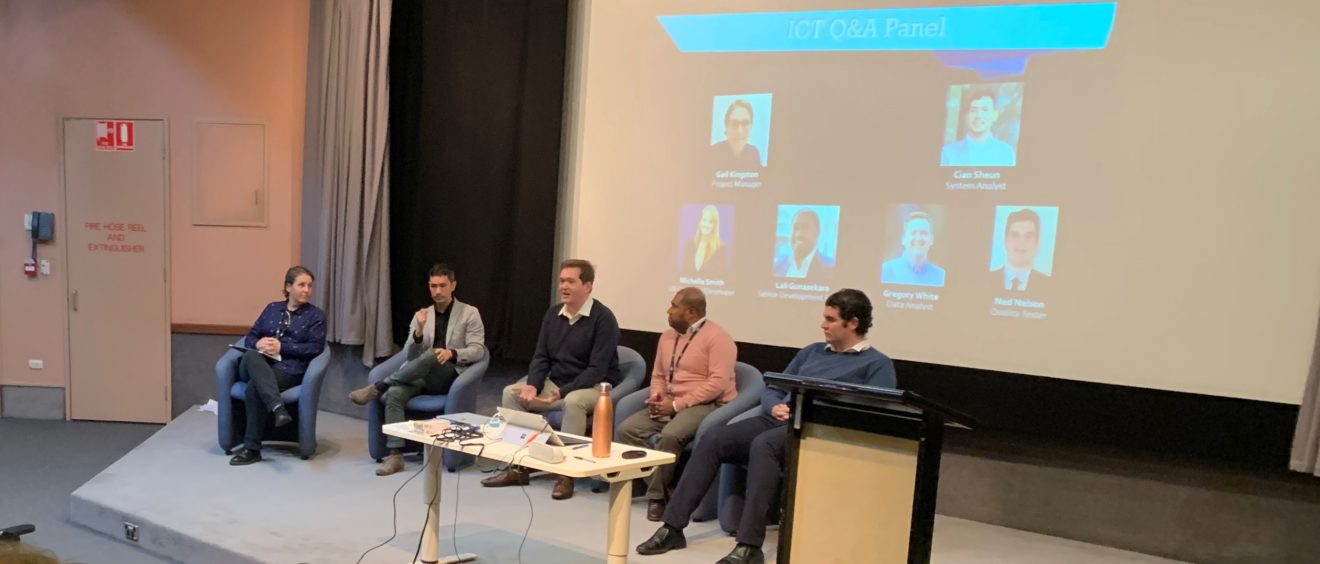
Client presentation on Business Systems Analyst role
I will talk about my presentation at my clients internal ICT event.
What was the event?
In June 2019, the Learning and Development team for my client approached me, and asked if I would present in their ICT Insights Event. I spoke to their audience on the role of Business Systems Analyst. The event was aimed at exploring what the ICT department and CIO group do within the organisation. My client has one of the biggest in-house software development teams in the Southern Hemisphere. Their organisation has about 40,000 staff members and processes around 700 million digital transactions per year. It is important for other parts of the organisation to understand the role of ICT. The intent of the event was also to promote the ICT industry and the organisation itself to young prospective ICT professionals.
What I did during the event
During the event I sat on a panel of five experts. We each represented our specific areas within the software development lifecycle (SDLC). The following roles were presented; Project Management, Analysis, Development (Programming), Data Analytics and Testing. I spoke about the Analysis component of my client’s SDLC, which in my opinion also covers system design and parts of business analysis (non-technical work).
The first time the event was run, at the beginning of the year, each person presented on their role. Explaining what they did, how they fit in the SDLC and why they liked their role. The format was different this time round. We sat on a panel and the guests asked us questions, after a brief explanation of what SDLC is and our job descriptions. I think this format worked better. Probably one improvement would be to have one person explain in simple terms what we do and why we do it. But the panel format worked very well.
We had 3 different audience groups throughout the day, highschool students, university students and internal non-ICT staff members. It was great to have the variation in audience groups, different ages, interests and experiences in the ICT industry. I think a great communicator is able to tailor their words their audience. WIRED do a great job of explaining ICT concepts at different levels, here is an example – Blockchain Expert Explains One Concept in 5 Levels of Difficulty. This is what I aimed to do with my talk.
My topics and points of interest.
The points of interest I wanted to convey were different for each group. I had to think hard about what they might want to know and how best to explain it.
Highschool Students
For the highschool students, I assumed they had some interest in ICT or else they wouldn’t have joined the event. I also assumed they had no idea how software was built, but they liked ‘technology’ in general. This I assumed means they like the end product, but not the ‘how’ of building the technology, which is what my job focus is. Also, after discussing with the teachers, mostly the students are taught programming. They don’t learn anything about software design, problem solving or analysis. I wonder if there is room for lateral thinking subjects in schools. At about 10 years old, my teacher introduced a Chess tournament to our class. I won it two years in a row. It would have been great if there was some subjects on the topic of problem solving and analysis.
I wanted to spark their interest in the ICT industry, to do this I explained that working in ICT is like a magic key into any life you could dream of. What I mean by this is, that you can find a role in ICT in almost any industry or country, doing anything you can imagine. Say for example you like playing the piano and you want to travel, but I don’t like programming. I described to the audience that I have a friend who works for a startup company in Berlin that is making a mobile app to teach you how to play the piano, and she works as a product manager. She learns how to play the piano at work and she helps decide what customers need in order to use the app in the best way possible.
University Students
It was clear from the questions coming from the university cohort that most of them were studying programming, data or cyber security. There was no one interested in software design or analytics. So I needed to do some advertising for the role of Business Systems Analyst. Usually my angle with inspiring people for this role is that you don’t need to have a strong working knowledge of computer science or programming languages. It helps, but what is important is your problem solving skills and ability to understand a problem and influence a group of people to adopt a solution. I have noticed that the role of analyst in software design, is something that progresses once having worked in software design for a few years. Similar roles that one can transition to include project manager, product manager, agile coach, team leader, solution design and many more.
Internal Staff
The internal staff were not at all interested in working in ICT or joining our department. They were more interested in how we operate and why we make certain decisions. Also, possible outcomes for specific projects, but I won’t discuss those here. For me it was great to hear the questions from internal non-ICT staff to gauge what their perception of the ICT department is and what our role in the organisation is. One question that stood out, that is not specific to my organisation, but relevant to all large organisations with in-house development.
Why do you release software that doesn’t work?
It was a brave question to ask, and great to get such honest discourse. I have strong opinions on the relationship between expectations and outcomes. In software development and in real life. I prefaced with the clear fact, ICT never intends to deliver ‘something that doesn’t work’. Plain and simple. I explained in many cases there is a 3 way tug-of-war between what the technology can and can’t do, what the business owner requests and what the end users need. The room was full of end users, that’s important to note.
I went on to explain that in a large organisation enterprise software consists of not “one system”, but a network of many specialised pieces of software. And all of these pieces of software need to communicate with each other, often through other pieces of software. In the front end, it will look and feel like one system. However, behind the scenes there is a lot going on. On top of software there is the complexity of catering for different business teams, managing product owners and ensuring infrastructure is stable and functioning.
I think my clear and simple explanation was understood and appreciated. Often at events I see ‘techie experts’ answering audience questions, they rattle off a lot of jargon, and no one understands anything. While I understand technical talk, I don’t speak it, or at least don’t like speaking in jargon.
Some great questions raised by guests:
- Why do you release software that doesn’t work? – internal staff
- Where do you see yourself in the future? – highschool student
- What do you like most about your job? – highschool student
- What should I focus on to get to your role? – highschool student
- How did you get into your job position? – university student
My advice
My advise for high-school students
For a pathway to software design and analysis; keep asking questions. One of the greatest strengths of a Business Analyst, is the ability to ask one question which gives you many answers. This will lead to fewer and better quality questions. This is useful in all walks of life.
My advice for University students
Consider job roles in software analysis and design. The role of Business Systems Analyst could be a good fit, if you are not interested in programming. The role requires a high degree of problem solving and lateral thinking.
My advice to service staff
Pressure your managers, business leaders to open up communication with the ICT department. Let us come visit you to see how you do your job. Let us see first hand what problems you’re experiencing. Engage early and often.
The role of the Business Systems Analyst is still evolving. It is some what unknown in today’s ever changing IT landscape. And various incarnations of the role are being created all the time, but the function remains just as important.

